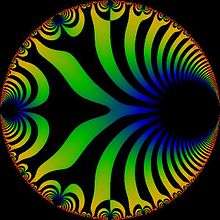Dedekind eta function

In mathematics, the Dedekind eta function, named after Richard Dedekind, is a modular form of weight 1/2 and is a function defined on the upper half-plane of complex numbers, where the imaginary part is positive.
Definition
For any complex number τ with Im(τ) > 0, let q = exp(2π i τ), and define the eta function by,
The notation is now standard in number theory, though many older books use q for the nome . Raising the eta equation to the 24th power and multiplying by (2π)12 gives
where Δ is the modular discriminant. The presence of 24 can be understood by connection with other occurrences, such as in the 24-dimensional Leech lattice.
The eta function is holomorphic on the upper half-plane but cannot be continued analytically beyond it.


The eta function satisfies the functional equations[1]
More generally, suppose a, b, c, d are integers with ad − bc = 1, so that
is a transformation belonging to the modular group. We may assume that either c > 0, or c = 0 and d = 1. Then
where
Here is the Dedekind sum
Because of these functional equations the eta function is a modular form of weight 1/2 and level 1 for a certain character of order 24 of the metaplectic double cover of the modular group, and can be used to define other modular forms. In particular the modular discriminant of Weierstrass can be defined as
and is a modular form of weight 12. (Some authors omit the factor of (2π)12, so that the series expansion has integral coefficients).
The Jacobi triple product implies that the eta is (up to a factor) a Jacobi theta function for special values of the arguments:
where is "the" Dirichlet character modulo 12 with , . Explicitly,
The Euler function
related to by , has a power series by the Euler identity:
Because the eta function is easy to compute numerically from either power series, it is often helpful in computation to express other functions in terms of it when possible, and products and quotients of eta functions, called eta quotients, can be used to express a great variety of modular forms.
The picture on this page shows the modulus of the Euler function: the additional factor of between this and eta makes almost no visual difference whatsoever (it only introduces a tiny pinprick at the origin). Thus, this picture can be taken as a picture of eta as a function of q.
Combinatoric identities
The theory of the algebraic characters of the affine Lie algebras gives rise to a large class of previously unknown identities for the eta function. These identities follow from the Weyl-Kac character formula, and more specifically from the so-called "denominator identities". The characters themselves allow the construction of generalizations of the Jacobi theta function which transform under the modular group; this is what leads to the identities. An example of one such new identity[2] is
where is the q-analog or "deformation" of the highest weight of a module.
Special values
The above connection with the Euler function together with the special values of the latter, it can be easily deduced that
Eta quotients
Quotients of the Dedekind eta function at imaginary quadratic arguments may be algebraic, while combinations of eta quotients may even be integral. For example, define,
then,
and so on, values which appear in Ramanujan–Sato series.
See also
- Chowla–Selberg formula
- Ramanujan–Sato series
- q-series
- Weierstrass's elliptic functions
- Partition function (number theory)
- Kronecker limit formula
- Affine Lie algebra
References
- ↑ Siegel, C.L. (1954). "A Simple Proof of ". Mathematika. 1: 4. doi:10.1112/S0025579300000462.
- ↑ Fuchs, Jurgen (1992), Affine Lie Algebras and Quantum Groups, Cambridge University Press, ISBN 0-521-48412-X
Further reading
- Tom M. Apostol, Modular functions and Dirichlet Series in Number Theory (2 ed), Graduate Texts in Mathematics 41 (1990), Springer-Verlag, ISBN 3-540-97127-0 See chapter 3.
- Neal Koblitz, Introduction to Elliptic Curves and Modular Forms (2 ed), Graduate Texts in Mathematics 97 (1993), Springer-Verlag, ISBN 3-540-97966-2